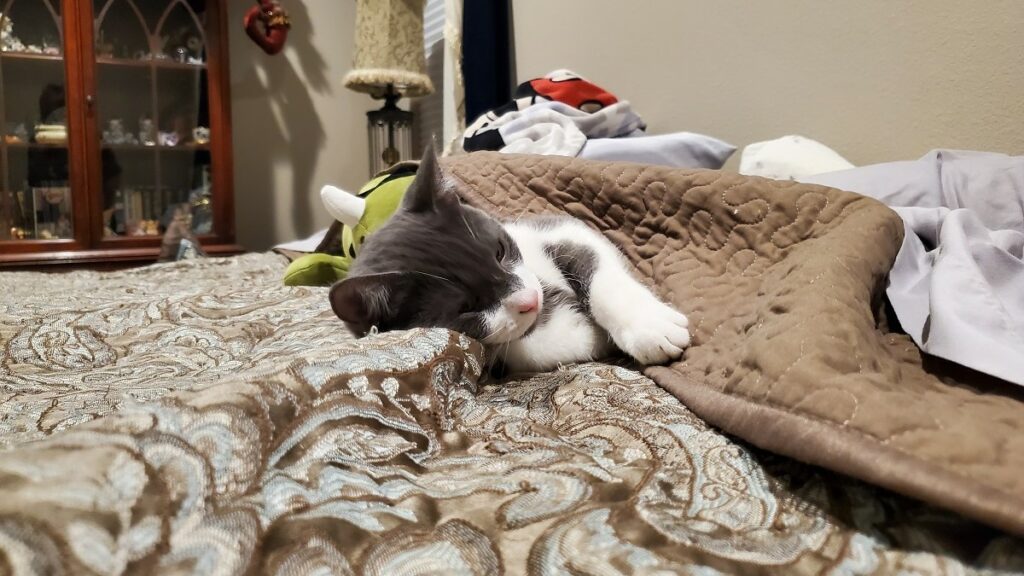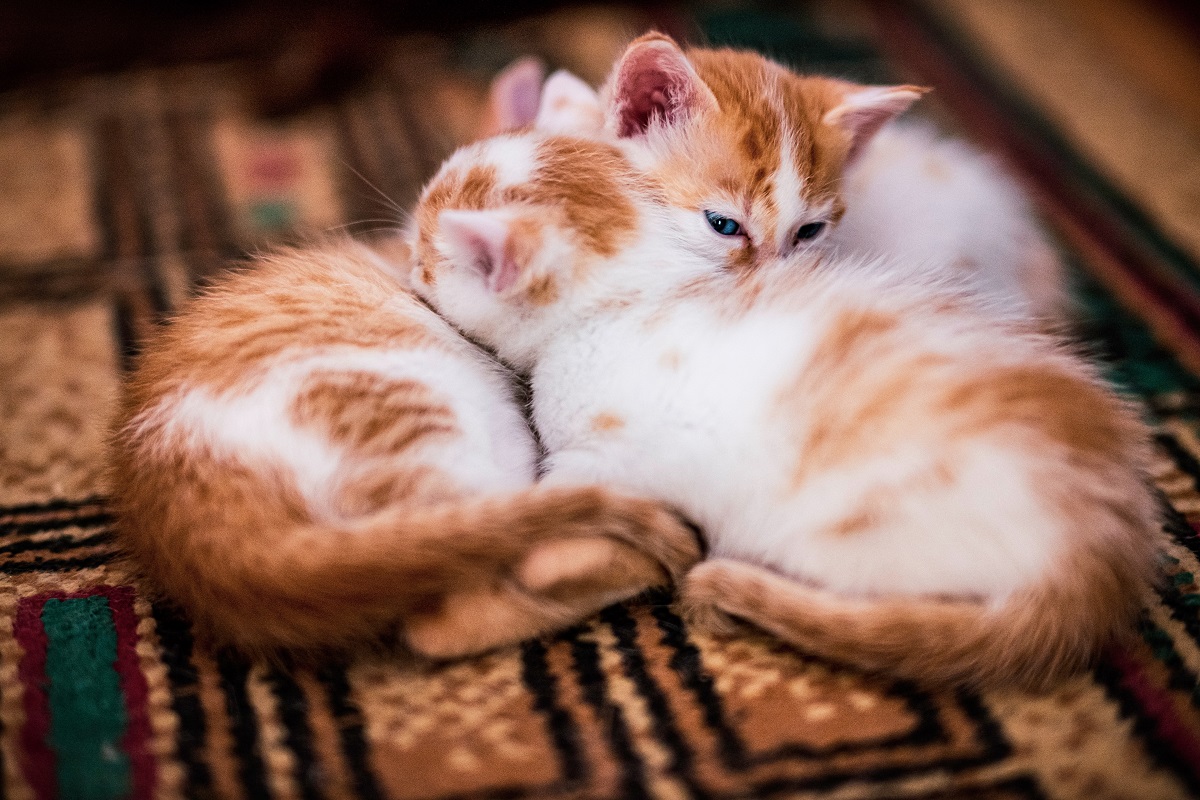Kittens seem like tiny, purring bundles of chaos. But underneath the fluff, there’s a surprisingly precise timeline of biological upgrades, behavioral experiments, and emotional development. The first year of a cat’s life is a whirlwind of changes. They go from blind, squeaky nuggets to confident, pouncing weirdos with opinions and favorite sun spots.
Understanding how kittens grow, learn, and change doesn’t just help you raise a happy cat. It makes your job easier. Because when you know what to expect (and how to help), you get fewer scratched hands, more cuddles, and a bond that actually lasts.
So, let’s walk through the developmental stages of kittens, from pink potato to full-blown feline, and talk about how to support your kitten every step of the way.
Neonatal Stage (0 to 2 Weeks)
Helpless, hair-trigger potatoes
At birth, kittens are about 90% fluff and 10% squeak. They can’t see, hear, or do much more than sleep and nurse. It’s adorable, but also extremely fragile.
What’s happening:
- Eyes and ears are sealed shut
- Can’t regulate body temperature
- Umbilical cords fall off around days 3-5
- Nurse every 1-2 hours
- Mom stimulates them to urinate and defecate
What they need:
- Warmth: Keep the environment around 85-90°F
- Clean bedding and low light
- If mom isn’t around, you’ll need to bottle feed, help them potty, and basically be their full-time life support system
🐣 Fun fact: Their purring reflex kicks in before their eyes open.
Transitional Stage (2 to 4 Weeks)
Wobbly awakening begins
They’re still needy, but now they’re looking around, testing their limbs, and discovering there’s more to the world than their next meal.
What’s happening:
- Eyes start to open (usually between 7-10 days)
- Ears unfold and hearing develops
- Baby teeth start to erupt
- First real steps – emphasis on wobbly
- Purring, mewing, and tail twitching begins
What they need:
- Gentle handling for a few minutes each day (great for socialization)
- Continued warmth and a clean, safe nest
- A shallow litter tray (they won’t use it yet, but exposure helps)
🧠 Pro tip: Even before walking is steady, kittens start learning from touch and smell. Handling them gently builds trust early.
Socialization Stage (4 to 8 Weeks)
Cute, curious, and a little unhinged
This is prime time for learning social skills. Kittens explore, play, bite, and wrestle their way through life, absorbing everything they experience.
What’s happening:
- Sight and hearing are fully functional
- Motor coordination improves rapidly
- Wrestling and mock-hunting games dominate playtime
- Start eating solid food while still nursing
- Begin using the litter box regularly
- Learn bite inhibition and social hierarchy from littermates
What they need:
- Short, gentle human interaction multiple times per day
- Kitten-safe toys and climbing opportunities
- Early socialization with people, soft sounds, and everyday objects
- High-quality wet food in shallow dishes
🐾 Development spotlight: This is the critical window for preventing fear and aggression later in life. Every positive experience builds a better adult cat.
Exploratory Stage (8 to 12 Weeks)
So much confidence, so little sense
This is the golden age of kittenhood. They’re energetic, bold, and ridiculously entertaining. But they also need guidance, consistency, and a crash course in manners.
What’s happening:
- Fully weaned and eating independently
- Adult eye color begins to develop
- Play mimics hunting: stalking, pouncing, biting
- Personality traits emerge: bold, cautious, vocal, quiet, etc.
What they need:
- Veterinary checkup and first core vaccinations
- Regular, structured playtime (feather wands, tunnels, chase toys)
- Continued exposure to new people and sounds
- Reinforcement of good behaviors using positive reinforcement
- Litter box hygiene and reinforcement
🎯 Training tip: This is a great time to teach “come,” “touch,” and crate training. Use treats and a clicker if you want to feel fancy (your cat will not be impressed).
Juvenile Stage (3 to 6 Months)
The tiny teenager
Now that they’ve mastered walking and pouncing, kittens double down on curiosity and start testing boundaries. Think of them as teens with claws. Charming, dramatic, and a bit impulsive.
What’s happening:
- Growth spurts: they gain ~1 pound per month
- Baby teeth fall out, adult teeth come in (yes, again)
- Hormonal changes start, especially in unspayed/unneutered kittens
- They test social limits with humans and other pets
What they need:
- Daily interactive play (they still can’t self-regulate boredom)
- Nail trims, brushing, and gentle restraint practice (read about cutting kitten claws)
- Ongoing litter training if needed (occasional regression is normal)
- Positive correction for rough play – redirect, don’t punish
🦷 Teething tip: Chewing intensifies. Offer kitten-safe chew toys and keep cords or string well out of reach.
Adolescent Stage (6 to 12 Months)
Looks like a cat, still acts like a raccoon
This is the most deceptive stage. They look like full-grown cats, but mentally? They’re still figuring things out. Expect sudden zoomies, weird vocalizations, and some light existential crises.
What’s happening:
- Reach sexual maturity (spay/neuter recommended around 5-6 months)
- Energy peaks, play gets rougher, confidence surges
- Personality continues to settle, but behavior is still malleable
- Bond with humans becomes stronger and more nuanced
What they need:
- Switch to adult food around 10-12 months (ask your vet)
- Continued training and enrichment: puzzle feeders, foraging mats, interactive toys
- Safe outdoor access (e.g., harness walks or a catio)
- Patience during boundary-testing and stubborn streaks
🧘 Behavior tip: Adolescents may regress (biting, scratching, clinginess). It’s normal. Keep redirecting and stay consistent.
Enrichment for Every Stage
Because kittens aren’t just growing. They’re learning.
At every age, your kitten’s brain is craving stimulation. Without it, boredom can lead to destruction, anxiety, or a cat who sleeps 20 hours a day because there’s literally nothing else to do.
Essentials:
- Sensory: Toys with different textures, sounds, and scents
- Cognitive: Puzzle feeders, training games, novel objects
- Physical: Climbing trees, shelves, and safe exploration zones
- Emotional: Cuddles, calm talking, and predictability
🧠 Keep rotating toys and spaces weekly to make things feel new and exciting.
Breed-Specific Timelines (Because Not All Cats Read the Same Manual)
Every kitten follows the same basic roadmap, but some take detours:
- Maine Coons: Keep growing until 3-4 years old; development is slow but steady
- Siamese and Orientals: Hyper-social from an early age and often more vocal
- Persians: Mature more slowly, and may be shy or reserved early on
- Bengals: Born wild. Need loads of stimulation, structure, and vertical space
Know your breed’s tendencies so you can tailor enrichment and expectations.

I’m a big boy now! See, I can sleep like Mom and Dad do! #BigBoyKitty #HeThinksHe’sPeople
Joey
Raising Orphaned Kittens
They didn’t choose the solo life, but with your help, they’ll thrive
Hand-rearing orphaned kittens is demanding but rewarding. You become their parent, teacher, and entire world.
What you’ll do:
- Bottle feed every 2–3 hours for the first 2–3 weeks
- Stimulate to eliminate (yep, every time)
- Monitor weight and hydration carefully
- Provide warmth and security at all times
- Start socialization early with gentle petting, toys, and sounds
❤️ Orphaned kittens may bond more closely with humans, and often grow into extremely affectionate adults.
The Developmental Stages of Kitten by Week
A cheat sheet for the kitten-raising life
| Age | What to Expect |
|---|---|
| 1 week | Eyes closed, nursing, can’t regulate temp |
| 2 weeks | Eyes open, ears unfolding, starting to crawl |
| 3 weeks | Baby teeth, first steps, purring |
| 4 weeks | Play starts, litter box intro, more movement |
| 6 weeks | Exploring everything, eating solid food |
| 8 weeks | Weaned, using litter box, first vaccinations |
| 12 weeks | Stronger play, climbing, bonding |
| 16–20 weeks | Teething, growth spurt, training progress |
| 6+ months | Spay/neuter, personality blooms, independence |
Final Thoughts: Kittenhood Is a Sprint and a Marathon
Kittens change fast. Sometimes overnight. But with patience, a sense of humor, and a little strategy, you’ll raise a confident, loving cat who trusts you, respects you (most days), and maybe even comes when you call. So stock up on treats. Get ready for zoomies and enjoy the ride! Kittenhood is fleeting, but unforgettable.
Sources:
– Cornell Feline Health Center
– Alley Cat Allies
– AAFP Feline Behavior Guidelines
– ASPCA
Recent Posts
Your Cat Might Be a Furry Little Healer… or at Least a Fuzzy Alarm System If you’ve ever had your cat suddenly become extra clingy when you’re under the weather, you’re not alone. From...
Cats are experts at hiding things, socks under furniture, their disdain for your playlist, and, unfortunately, symptoms of illness. In the wild, showing weakness could make them a target, so even...


